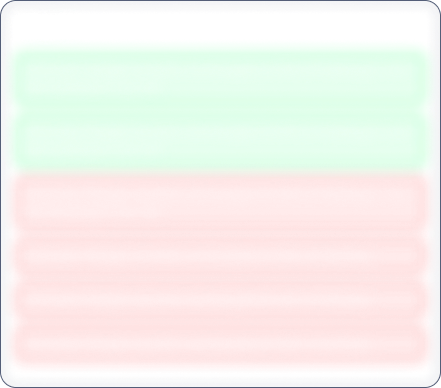Year End Sale 50% off
KMC Speciality Hospitals (India)

No Data Available
Investor Sentiment
KMC Speciality Hospitals (India) Share price and Fundamental Analysis
Key Metrics
Included In
Stock Returns
Stock Heatmap

No Stocks
Smart Score

Unlock Smart Score
See Detailed Analysis & Insights


Unlock Insights
See Detailed Analysis & Insights
Technicals
Returns Calculator
If you would have investedResearch Report
No Research Report
Corporate Action
Financials
Key Ratios
ROE
Avg ROE (3 Yrs) : NaN%
ROCE
Avg ROCE (3 Yrs) : NaN%
ROA
Avg ROA (3 Yrs) : NaN%
NPM
Avg NPM (3 Yrs) : NaN%
Dividend History
5 Year FactSheet
Documents

No Data Available
News
KMC Speciality Hospitals (India) Management and History
Company Management


Unlock Management Data
See Detailed Analysis & Insights
Company History
KMC Speciality Hospitals (India) Ltd is a part of the KMC group of hospitals based at Tiruchirappalli. The company is in the business of running a super speciality hospital having 175 beds with team of dedicated specialists. They provide quality healthcare to patients in key specialty areas such as Neurosurgery, Cardiovascular & thoracic surgery, Orthopedics, Plastic and Reconstructive Surgery, Gynecology, Neonatology and Nephrology (including renal transplants).
The Company is primarily engaged in the business of rendering Medical and Healthcare Services. They have the state-of-the-art equipments and trained personnel required for managing critically ill patients. Our hospital is fully equipped to deal with all kinds of accident victims 24 hours a day.
KMC Speciality Hospitals (India) Ltd was incorporated on December 31, 1982 as a private limited company with the name Advanced Medical Care Pvt Ltd. In July 15, 1998, the company was converted into a public limited company and the name was changed to Advanced Medical Care Ltd. In July 1992, they came out with the public issue.
In March 1994, the management of the company was changed to Seahorse group. In March 21, 1995, the name of the company was changed from Advanced Medical Care Ltd to Seahorse Hospitals Ltd, pursuant to the change in management.
In April 2008, Sri Kavery Medical Care (Trichy) Ltd tool over the company by way of acquisition of shareholding of the Seahorse group and subsequent open offer. Also, the name of the company changed to KMC Speciality Hospitals (India) Ltd with effect from October 24, 2008.
Thus, the company became a part of the KMC Group of Hospitals. The KMC group companies are engaged in the business of health care services, medical laboratory services, treatment of cardiac diseases, Investigations, healthcare institutions, imparting related training and education.
During the year 2011-12, the Hospital inaugurated State of the art NICU & Pediatric facility; added sophisticated Leica Microscope and 3D Scan, Sleep Lab, added additional lift facility for patients, facelift of the 2nd Floor, 3rd Floor and reception & lobby area, renovated and expanded the Triage facility, started construction of exclusive patient rooms.
During the year 2013-14, Neurosurgery, Advanced Gastroenterology Procedures, Bariatric Surgery for Obesity and Joint Replacement and Arthoscopy Surgical Procedures were launched. The Hospital inaugurated 24 hours treatment of Hand injury and micro surgery unit and Geriatrics Department.
KMC Speciality Hospitals (India) Share Price
KMC Speciality Hospitals (India) share price reflects investor sentiment toward the company and is impacted by various factors such as financial performance, market trends, and economic conditions. Share price is an indicator which shows the current value of the company's shares at which buyers or sellers can transact.
KMC Speciality Hospitals (India) Market Cap
Market capitalization of KMC Speciality Hospitals (India) indicates the total value of its outstanding shares. Marketcap is calculated by multiplying share price and outstanding shares of the company. It is a helpful metric for assessing the company's size and market Valuation. It also helps investors understand how KMC Speciality Hospitals (India) is valued compared to its competitors.
KMC Speciality Hospitals (India) PE Ratio
KMC Speciality Hospitals (India) PE ratio helps investors understand what is the market value of each stock compared to KMC Speciality Hospitals (India) 's earnings. A PE ratio higher than the average industry PE could indicate an overvaluation of the stock, whereas a lower PE compared to the average industry PE could indicate an undervaluation.
KMC Speciality Hospitals (India) PEG Ratio
The PEG ratio of KMC Speciality Hospitals (India) evaluates its PE ratio in relation to its growth rate. A PEG ratio of 1 indicates a fair value, a PEG ratio of less than 1 indicates undervaluation, and a PEG ratio of more than 1 indicates overvaluation.
KMC Speciality Hospitals (India) ROE (Return on Equity)
Return on Equity (ROE) measures how effectively KMC Speciality Hospitals (India) generates profit from shareholders' equity. A higher ROE of more than 20% indicates better financial performance in terms of profitability.
KMC Speciality Hospitals (India) ROCE (Return on Capital Employed)
Return on Capital Employed (ROCE) evaluates the profitability of KMC Speciality Hospitals (India) in relation to its capital employed. In simple terms, ROCE provides insight to investors as to how well the company is utilizing the capital deployed. A high ROCE of more than 20% shows that the business is making profitable use of its capital.
KMC Speciality Hospitals (India) Total Debt
Total debt of KMC Speciality Hospitals (India) shows how much the company owes to either banks or individual creditors. In simple terms, this is the amount the company has to repay. Total debt can be a very useful metric to show the financial health of the company. Total debt more than equity is considered to be a bad sign.
KMC Speciality Hospitals (India) Debt to Equity Ratio
The Debt-to-Equity (DE) ratio of KMC Speciality Hospitals (India) compares its total debt to shareholders' equity. A higher Debt to Equity ratio could indicate higher financial risk, while a lower ratio suggests that the company is managing its debt efficiently.
KMC Speciality Hospitals (India) CAGR (Compound Annual Growth Rate)
CAGR shows the consistent growth rate of KMC Speciality Hospitals (India) over a specific period, whether it is over a month, a year, or 10 years. It is a key metric to evaluate the company’s long-term growth potential. Main metrics for which CAGR is calculated are net sales, net profit, operating profit, and stock returns.
KMC Speciality Hospitals (India) Technical Analysis
Technical analysis of KMC Speciality Hospitals (India) helps investors get an insight into when they can enter or exit the stock. Key components of KMC Speciality Hospitals (India) Technical Analysis include:
Support Levels (S1, S2, S3)
There are usually multiple support levels, but the main support levels for a stock are S1, S2, S3. Support levels indicate price points where stock might get support from buyers, helping the stock stop falling and rise.
Resistance Levels (R1, R2, R3)
There are usually multiple resistance levels, but the main resistance levels for a stock are R1, R2, R3. Resistance levels represent price points where KMC Speciality Hospitals (India) shares often struggle to rise above due to selling pressure.
KMC Speciality Hospitals (India) Dividends
Dividends refer to the portion of the company’s profits distributed to its shareholders. Dividends are typically paid out in cash and reflect KMC Speciality Hospitals (India) ’s financial health and profitability.
KMC Speciality Hospitals (India) Bonus Shares
Bonus shares are usually given by companies to make the stock more affordable, increase liquidity, boost investor confidence, and more.
KMC Speciality Hospitals (India) Stock Split
Stock split increases the number of its outstanding shares by dividing each existing share into multiple shares. When the company offers a stock split, the face value of the stock reduces in the same proportion as the split ratio.
KMC Speciality Hospitals (India) Financials
The financials of KMC Speciality Hospitals (India) provide a complete view to investors about its net sales, net profit, operating profits, expenses, and overall financial health. Investors can analyze financial data to assess the company’s stability and also understand how the company has been growing financially.
KMC Speciality Hospitals (India) Profit and Loss Statements
The profit and loss statement of KMC Speciality Hospitals (India) highlights its net sales, net profit, total expenditure, and operating profits in the current financial year. This Profit and Loss statement is crucial for evaluating the profitability and financial stability of KMC Speciality Hospitals (India) .
KMC Speciality Hospitals (India) Balance Sheet
The balance sheet presents a snapshot of KMC Speciality Hospitals (India) ’s assets, liabilities, and equity of shareholders, providing insights into the financials of the company.
KMC Speciality Hospitals (India) Cashflow Statements
Cashflow statements track the company's cash inflows and outflows over a period. It is an essential tool for understanding how well the company manages its liquidity and finances.


